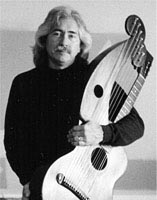
Regular columnist Stacy Hobbs takes a breather, as guest writer Stephen Bennett provides us with some of his arranging tips. |
Volume 4, Issue 1, May, 2006
|
|
MAKING MUSICAL CHOICES by Stephen Bennett | |
|
Editorís
Note: For this monthís column, Stephen has included a
PDF file of his music
example and a recording of
the same clip, for you to see and hear what he
is describing. |
|
|
Greetings, fellow harp guitarists! Iíve been asked to write a little bit about the process of arranging and composing for this wonderful instrument. So, here goesÖ Let me go back to one of the first tunes I arranged for harp guitar. That was Cole Porterís Begin the Beguine. I had admired this tune for several years already when in 1988 I acquired my great grandfatherís old Dyer. And I had been trying to come up with a good arrangement for it on 6-string, efforts that had proved unsuccessful thus far. The problem was that I really needed to have both a low D and a low E. Drop D was great for the D, but when I would need the 2nd fret low E, I would need to be simultaneously high up on the neck for the melody. This didnít seem possible. Sure, I could skip the drop D, use a higher octave D and then have the open 6th as an E, but that wasnít moving me either. With the tuning I had decided on for my newly found harp guitar, I could have both notes. And Ė voila Ė the tune started to fall into place. I would use my next to the closest sub-bass string; it was a D already. And the 6th string of the regular guitar was still an E. Other chords in the tune were G, A7, B7, F#m, and a couple of diminished sevenths. My tuning of the sub-basses already provided me with 2 Gs, an A and a B. This was looking promising! Better than just being promising from a standpoint of mere availability of bass notes, everything seemed to sit well under my fingers. And that was/is crucial. If something sits well under your fingers, thatís a good sign. Which is not to say that everything should be easy; it should not, but itís not a bad thing for much of a tune to be comfortable either. Here are the first few measures of my arrangement of Begin the BeguineÖ There are some things to notice. First, fairly minimal use of the sub-basses. Later on in the tune, most of the other sub-bass strings will be used, but thus far, only the D has. Yet, the effect that one note has is huge. It stays there underneath everything else going on and rings. And, in doing so, because it is the root note of the key, it helps to establish the tonality firmly. Note the descending bass line Ė D C# B A. Of those, again Ė only the D is a sub-bass string in this arrangement. I could have tuned my C string to C# and then I would have had each of the above listed notes as sub-bass strings. I intentionally did not do this. Itís better, in my humble opinion, to underutilize these strings. I think they are more effective that way. Second, notice how most of the melody notes are not directly on the beat. The basses, however, are. I do this for a variety of reasons. I donít like having to make the large stretches required to hit a melody note on a high string at the same time I am hitting a sub-bass note. I studiously avoided that early on. My hands just didnít like doing wide pinches. However, the musical benefit of doing this is great. The melody sounds lyrical this way; more like it might be sung. The bass falling regularly on the beat helps to set up the rhythm; the groove. To see what I am talking about, look at the last note of line one. It is the beginning of the melody. And itís all by itself, entering just before the bass note on the first beat of the following measure. Look at the A in measure 5 Ė same thing. It is struck and half a beat later the sub-bass D comes in. The wide pinch has been avoided. And quite musically so. So, for me the key to the choices I make musically (and thatís what is happening, isnít it; one is making musical choices when arranging) always takes into account things like this; how does this sit under my fingers? Can I actually do this? In the case of this tune, the choice of whether to do it on the 6-string vs. the harp guitar was clear; the latter was the superior choice. It is not always so. If a tune is of a faster tempo, many times I think the harp guitar is NOT the way to go. Which is certainly not to say that such cannot be done, but I do think that where the harp guitar particularly shines is in allowing the accumulation of long tones to develop. This would suggest slower tunes. On the basis of my experience, I will generally always put a slower tune on harp guitar. - SB |
|
Stephen Bennett should need no introduction to any harp guitarist not living under a rock. Visit http://www.harpguitar.com/ to see what he's up to! |
All Site Contents Copyright © Gregg Miner, 2004,2005,2006. All Rights Reserved.
Copyright and Fair Use of material and use of images: See Copyright and Fair Use policy.
|
If you enjoyed this article, or found it
useful for research, please consider making a donation to The
Harp Guitar Foundation, |
|
|
|
All Site Contents Copyright © Gregg Miner,2004-2020. All Rights Reserved. Copyright and Fair Use of material and use of images: See Copyright and Fair Use policy. |